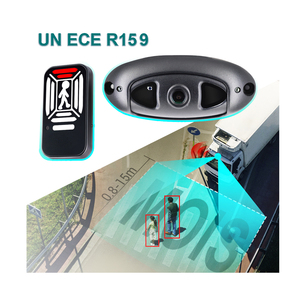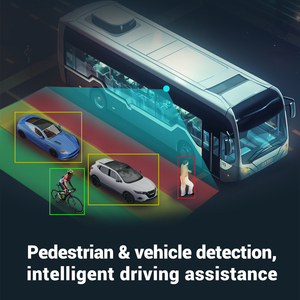(1858 products available)



























































































































































































































Manufacturers categorize anti-collision sensors based on different parameters. Below are some common categories:
Ultrasonic sensors
Ultrasonic sensors are perhaps the most commonly used anti-collision sensors. They use sound waves to detect obstacles. An ultrasonic sensor emits sound waves constantly. When a vehicle approaches an obstacle, the sound waves bounce back, and the sensor detects the change in frequency. It then alerts the driver. Most parking sensors use ultrasonic sensors.
Radar sensors
These sensors use electromagnetic waves to detect objects. Unlike ultrasonic sensors that emit sound waves, radar sensors emit radio waves. The working principle is similar to that of ultrasonic sensors. When the vehicle approaches an object, the radio waves bounce back. The sensor detects the change in frequency and alerts the driver. Radar sensors can work in all weather conditions. As such, they are widely used in adaptive cruise control and blind spot detection systems.
Lidar sensors
Lidar sensors are advanced anti-collision sensors that offer high precision. They use laser beams to detect objects. The sensor emits a laser pulse. When the pulse hits an object, it reflects back to the sensor. The time it takes for the pulse to return helps the sensor calculate the distance to the object. Lidar sensors are used in autonomous vehicles due to their high accuracy.
Camera-based sensors
These sensors use cameras to provide a visual feed of the surroundings. They rely on computer vision algorithms to detect obstacles. The cameras can provide a wide field of view. Anti-collision systems that use camera-based sensors can offer features like lane-keeping assistance and pedestrian detection. Since these sensors depend on light, they may have limited effectiveness in low-light conditions.
Infrared sensors
Infrared sensors detect heat emitted from objects. They are mainly used in low-light conditions where other sensors may be less effective. The anti-collision systems that use infrared sensors complement other sensor types. For instance, they can enhance the functionality of camera-based or lidar sensors in low-light environments.
Manufacturers of anti-collision sensors provide the following specifications to help buyers understand the capabilities of different models.
It is also important to maintain anti-collision sensors so they continue to function well and reduce the risk of collisions. Here are some maintenance requirements:
Choosing the right collision sensor technology requires a careful understanding of the needs and operating conditions. Here are some factors to consider:
Choosing the right anti-collision sensor technology requires a careful understanding of the needs and operating conditions. Here are some factors to consider:
Replacement of anti-collision sensors can be done as a DIY project. However, it is important to have the right knowledge and skills to perform the replacement. It is also important to read the vehicle's user manual to understand the system better. Below are the general steps to follow when replacing the sensor.
Gather all the necessary tools that will be needed for the replacement. This includes a socket set, screwdrivers, and the anti-collision sensor. Park the car in a safe and level place. This will ensure that the sensor is mounted in a level position which is important for its accuracy. Power off the vehicle and locate the sensor. This may be different depending on the sensor's location and the vehicle model. The front sensors are located on the front bumper, while the parking sensors are located on the rear bumper. Once located, remove the old sensor. This is done by unscrewing it from its mounted place and disconnecting the wiring plug.
Once the old sensor has been removed, the spot should be cleaned and free from debris. This is to ensure that the new sensor is mounted well and works perfectly. After cleaning, install the new anti-collision sensor. This is done by first connecting the wiring plug and then mounting it using the screws. After installing the new sensor, it is important to test it and make sure it is working properly. This can be done by performing a sensor calibration which is done differently depending on vehicle models. To be sure that the sensor is working well and safely, take the car to a professional to inspect it.
Some of the tools that are needed to install and replace anti-collision sensors are; Screwdrivers, socket set, and trim removal tools
Q1. Can an anti-collision sensor be installed on any vehicle?
A1. Generally, it's possible to install anti-collision sensors on most vehicles. However, the compatibility and installation process can vary depending on the vehicle's make and model. It's best to check with the manufacturer or a professional installer.
Q2. Do anti-collision sensors work in all weather conditions?
A2. Anti-collision sensors are designed to function in various weather conditions. However, extreme conditions like heavy rain, fog, or snow can affect the performance of some types of sensors (like ultrasonic sensors) by temporarily reducing their effectiveness.
Q3. How do anti-collision sensors affect vehicle maintenance?
A3. Anti-collision sensors require regular maintenance like any other part of the vehicle. Keeping them clean and ensuring they are functioning properly is essential. This may add a small amount of extra work to vehicle maintenance routines, but the added safety can often be worth it.
Q4. Can anti-collision sensors detect pedestrians and cyclists?
A4. Some advanced anti-collision systems are designed to detect pedestrians and cyclists. These systems typically use a combination of radar, cameras, and advanced algorithms to identify and react to vulnerable road users. However, not all anti-collision systems have this capability.
Q5. What should be done if the anti-collision sensor gives false warnings?
A5. If the anti-collision sensor system gives frequent false warnings, it could be a sign of dirt buildup, misalignment, or a technical issue. The sensors should be cleaned, visually inspected, and possibly adjusted. If the problem persists, it's important to get the system checked by a professional.